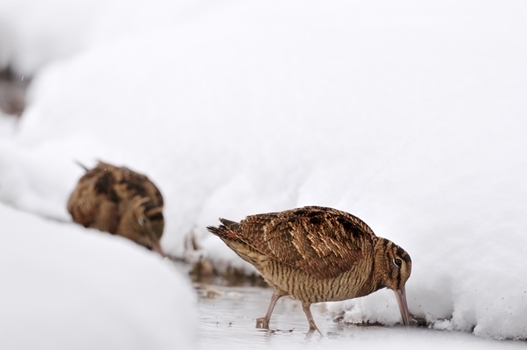We have recently published Conserving Our Woodcock, a new guide which turns 50 years of GWCT woodcock research into practical guidance on how to provide the varied habitat woodcock require. This blog is taken from the guide, which you can download in full here.

The question of how many woodcock might spend their winters in the UK may seem straightforward but is actually extremely difficult to answer. The fundamental reason is the secrecy of these birds, so that simple counting of those we may see in winter is not an accurate reflection of the number that might be present, camouflaged in the woods and active at night. Therefore, the usual approach to estimating winter numbers has been:
- Take the relatively reliable estimate of breeding males in spring.
- Assume a broadly similar number of females.
- Account for the loss that would be expected through the summer.
- Add the average number of young each female might rear in that season.
- Use the proportion of resident breeders to migrants to calculate the total number present in the winter.
There are many difficulties with this process. Putting aside the several assumptions that must be made in steps 1-4 which provide a baseline number of British breeding birds that are present in the winter, the main challenge is establishing the relative numbers of resident to migrant woodcock in Britain in the winter.
The various sources of data that can be used to estimate the percentage of our winter population that are resident range from ringing studies, which suggest around 14%, to isotope analysis of feathers, which can suggest as low as 2%. The root of this variation probably lies in the inherent differences between different areas.
Some areas of the country such as Cornwall and Wales have no breeding woodcock and almost all woodcock present in winter will be migrants. Other areas, such as some of our study sites in Hampshire, have relatively high breeding populations and therefore even when winter migrants arrive, the proportion of residents may be as high at 20%.
Ringing studies have been carried out for many years and can give very reliable data. They tend to be focused on areas which have a relatively high population of resident breeders, so probably only accurately represent these pockets of the UK. Isotope studies are also dependent on where sampling takes place, how many feathers come from these different sites, and how the analysis is carried out.
Isotope studies have the potential to give a truly national proportion – if the sites are well spread and cover all areas. However, they will inevitably be biased towards areas where woodcock are shot.
This wide range of possible resident proportion has a huge impact on the final figures of any estimate. If we take a reasonable starting figure of 137,500 resident woodcock present in Britain in the winter, and a resident bird percentage of 2-17%, this leads us to a winter population estimate of between 808,800 and 6,875,000.
The generally accepted figure at present for the British winter population estimate is somewhere between 800,000 and 1,500,000, which would mean that between 9-17% of woodcock present in winter are resident.